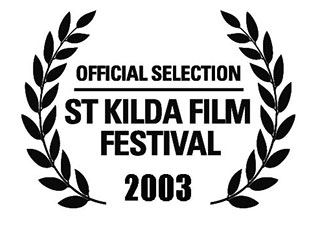Australian Cinema Ensemble
| Angelo Salamanca Australian Cinema Ensemble |
2002, 15 mins, drama, 35mm Director: Angelo Salamanca Cast:John F. Howard, Georgia Van Cuylenburg, Michael Burkett, Drew Tingwell, Tamara Donnellan, Penelope Bartlau, Stuart Bowden. St. Kilda Film Festival; In The Realm Of The Senses; Fitzroy Shorts. |
 |
Late one evening, whilst driving on a dark and quiet road, gruff father Blowfly and his beautiful young daughter Fly, appear to run down a creature, a Roach, which suddenly comes into view in the middle of the road. Whilst the dominating Blowfly checks for damage, or a body, he is strangely lured into a building, The Place, across the road by the very creature whom he appeared to run down.
The fable "The Spider and the Fly" is an allegory dramatising the loss of innocence. The basic premise is an obvious one: the dangers of being seduced by what we instinctively know to be harmful but which we still feel compelled to savour. The tale, in the style which we are telling it, is imbued with dark, gothic tones but leavened with bacchanalian revelry and a celebration of sensuality. This use of colour and movement will serve to beguile innocence personified - in this case, "Fly". Like Lewis Carroll's "Alice", Fly will be introduced to a world comprising a bevy of characters whose human and animal traits meld. Mary Howitt's poetry/dialogue is mainly written in iambic heptameter (seven beats to each line with stresses falling on alternate beats). As with Shakespeare's poetry/plays, though the meter should be respected, our aim is for a speech pattern which resembles normal speak. Our objective is for the viewer to identify with "Fly" and be swept away by the "music" of the poetry, the cinematic language and the strong audio/visual elements. Of course we run the danger of distancing our audience if the story is told in too stylised a manner. It's important that in world we are creating, the marriage of naturalism and artifice, is a happy one. The following, lists aforementioned human characters with animal traits. Our intention is to find a balance between what is credible and what is not - in other words, to what degree will an audience suspend disbelief without compromising the story's dramatic pull? |
